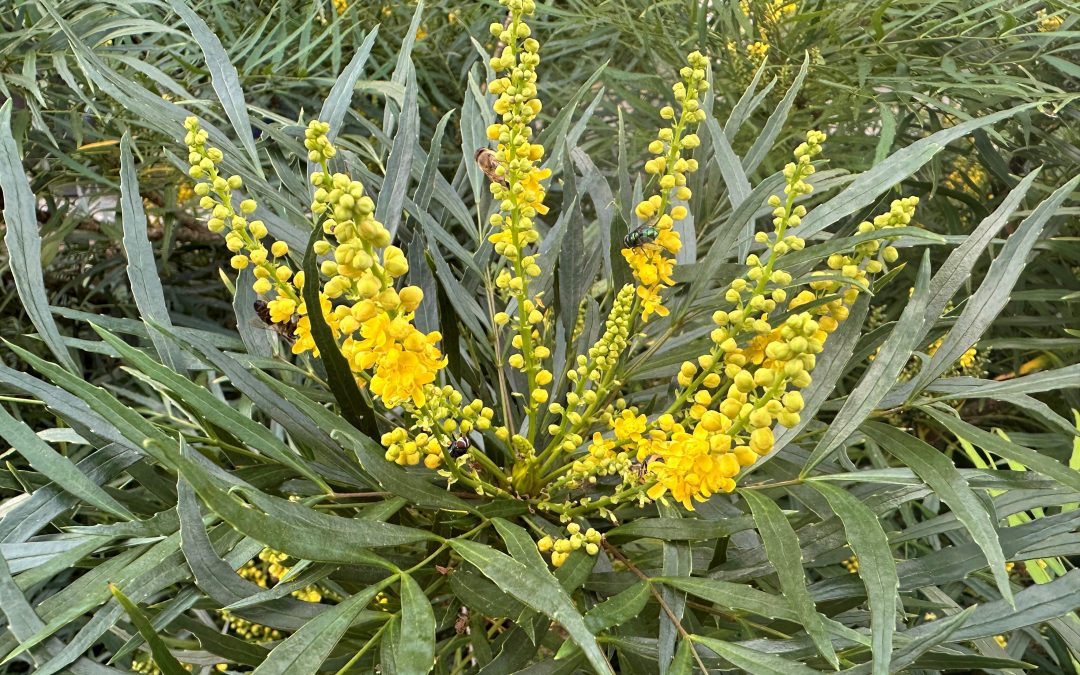
by Daniel J. Leonard | Nov 13, 2024
One of my favorite landscape plants is blooming right now in Panhandle landscapes – ‘Soft Caress’ Mahonia. ‘Soft Caress’ was first introduced into the commercial nursery trade in 2006 and included in the Southern Living Plant Collection, but didn’t achieve garden fame until 2013 when it won first place in the Royal Horticultural Society’s (RHS) prestigious Chelsea Flower Show. I first planted a group of ‘Soft Caress’ about ten years ago and as those plants have matured, so too has my appreciation for them. The following are a couple of my favorite outstanding aspects of these small shrubs.
Fall Flowers. Other than camellias, there isn’t a lot else in Panhandle landscapes blooming from mid-November to January and ‘Soft Caress’ Mahonia helps fill that flower void. Brilliant yellow flower spikes rise above the deep-green fernlike foliage and very welcome in this otherwise drab and dreary gardening season.

‘Soft Caress’ Mahonia’s winter flowers are excellent pollinator attractors. Photo courtesy Daniel Leonard.
Quick growing but small statured. If you’ve gardened very long, you’ll know this is a tough ask! Plants that reach mature size relatively rapidly but also don’t get very big are a rare breed. ‘Soft Caress’ Mahonia grows quickly but also maxes out in size rather quickly – mine are very easily maintained at 3-4’ in height with a single annual trim.

~10-year old ‘Soft Caress’ Mahonia Shrub. Photo courtesy Daniel Leonard.
Extremely tough and adaptable. My Mahonia plants have persisted through drought, hurricanes, floods, and freezes and have never looked better. These little plants are simply tough. They’ve had no disease issues and no pest problems (except for a little deer browsing one year, but that appears to be an isolated incident). While they prefer shade, they can also handle several hours of morning sun without incident.
‘Soft Caress’ Mahonia is a standout plant that fills a mostly flowerless period in landscapes, fills its designated landscape spot quickly but won’t outgrow it, and is truly tough. Add a couple to your landscape this winter!
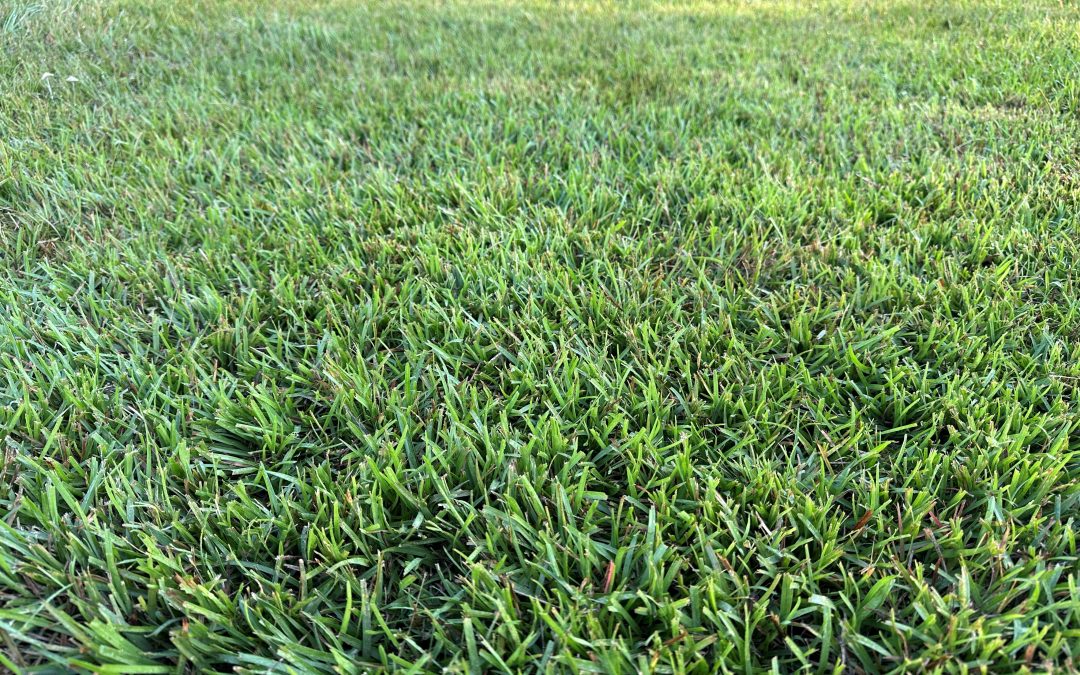
by Daniel J. Leonard | Oct 4, 2024
It’s hard to have a great yard full of Centipedegrass isn’t it? All the fertilizer, watering, aerating, weed spraying, fungicide spraying, insect spraying, the list is never-ending and wallet draining. Except, it’s not hard and doesn’t have to be expensive. It’s easy. In fact, it’s so easy that people even make it hard because they think it should be. The list of basic tips to achieve a great yard of Centipedegrass is very short, let’s get into it.
Fertilizing Properly – Keep it to a minimum! Centipedegrass has a very low Nitrogen (N) requirement for optimum growth and development (0.4 lbs – 2 lbs/1000 ft 2 per year). Centipede is naturally light green in color and trying to force the deep green of Kentucky Bluegrass upon it will almost certainly do it harm. There are many excellent quality Centipedegrass lawns in the Panhandle that have never received a single prill of fertilizer. Don’t take my word for it though, the UF/IFAS publication Centipedegrass for Florida Lawns says, “Established centipedegrass lawns require about 50% less nitrogen fertilizer than other lawn grasses grown in Florida. Centipedegrass is a low maintenance turfgrass and does not respond well to excessive use of fertilizer, especially nitrogen.”

Centipedegrass lawn that has never been fertilized and mowed regularly when it reaches 3″ to achieve a 2.5″ cut height. Photo courtesy Daniel Leonard.
Timely Mowing – Other than overfertilizing, the next easiest way to cause significant damage to a Centipedegrass lawn is to mow it incorrectly. Centipede prefers a mowing height of around 2.5” and actively growing grass should be mowed every 7-14 days, removing no more than 1/3 of the grass blade. In my experience, this is much higher and often less frequent than many people mow their lawns. All too often, I see Centipede lawns that are allowed to grow tall and unkempt and then mowed to near golf course fairway height with the occasional bare “scalped” spot where the mower ran across an unlevel area of lawn. Mowing short and infrequently is harmful because mowing is inherently a major stress to the grass. You’re asking a lot of a plant by removing a large chunk of photosynthetic leaf tissue and then repeatedly asking the plant to regrow. Be kind to your grass and mow correctly. *Additionally, try to not mow your lawn in droughty conditions as this can exacerbate mowing stress and cause serious lawn issues.
Right Plant, Right Place – Much of the bad rap turfgrass receives comes from people trying to force it to grow where it shouldn’t be. If your yard has areas of significant shade or receives significant foot or vehicle traffic, Centipedegrass (or most any grass for that matter) may not be for you, in those areas at least. Like all turfgrasses (though some are more shade and traffic tolerant than others), Centipedegrass does best in full sun and detests having the soil its roots are going in repeatedly trampled and compacted. In areas with those conditions, maybe having a mulched landscaped bed with shade tolerant plants or a rocked walking path would be more appropriate. You and the grass will certainly be happier working with those options than fighting against your site conditions.
Though maintaining a Centipedegrass lawn is simple, that isn’t to say that if you follow all these tips that your yard will be perfect all the time. There will still be the occasional dieback, weed ingression, mole cricket infestation and the like, however, following the above tips will make your grass much more resilient and equipped to handle those stresses. For more information about Centipedegrass or other horticultural topics, contact your local UF/IFAS Extension office. Happy gardening!
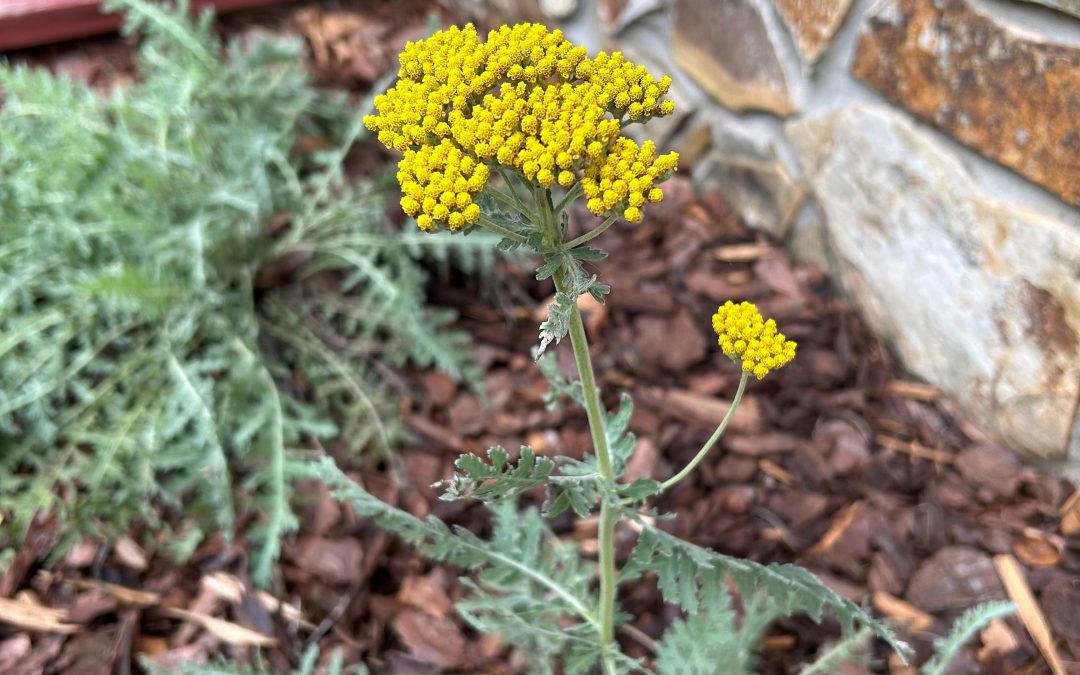
by Daniel J. Leonard | Sep 19, 2024
Problem areas in the landscape – everyone has them. Whether it’s the spot near a drain that stays wet or the back corner of a bed that sunshine never touches, these areas require specialized plants to avoid the constant frustration of installing unhealthy plants that slowly succumb and must be replaced. The problem area in my landscape was a long narrow bed, sited entirely under an eave with full sun exposure and framed by a concrete sidewalk and a south-facing wall. This bed stays hot, it stays dry, and is nigh as inhospitable to most plants as a desert. Enter a plant specialized to handle situations just like this – Yarrow ‘Moonshine’.
Yarrow (Achillea spp.) is a large genus of plants, occurring all over the globe. To illustrate, Common Yarrow (Achillea millefolium) is native to three different continents (North America, Europe, and Asia), making it one of the most widely distributed plants in the world. And though it was commonly grown and used in antiquity for medical purposes (the genus name Achillea is a reference to Achilles, who supposedly used the plant as a wound treatment for himself and his fellow Greek soldiers), I and most of you are probably more interested in how it looks and performs in the landscape.
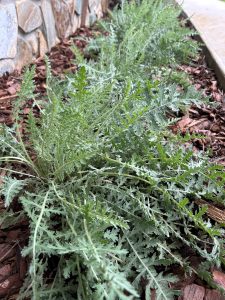
‘Moonshine’ Yarrow foliage.
All species of Yarrow share several ornamental traits. The most obvious are their showy flowers, which occur as large, flattened “corymbs” and come in shades of white, pink, red, and yellow. I selected the cultivar ‘Moonshine’ for my landscape as it has brilliant yellow flowers that popped against the brown wall of the house. Equally as pretty and unique is the foliage of Yarrow. Yarrow leaves are finely dissected, appearing fernlike, are strongly scented, and range in color from deep green to silver. Again, I chose ‘Moonshine’ for its silvery foliage, a trait that makes it even more drought resistant than green leaved varieties.

‘Moonshine’ Yarrow inflorescence.
If sited in the right place, most Yarrow species are easy to grow; simply site them in full sun (6+ hours a day) and very well drained soil. While all plants, Yarrow included, need regular water during the establishment phase, supplemental irrigation is not necessary and often leads to the decline and rot of Yarrow clumps, particularly the silver foliaged varieties like ‘Moonrise’ (these should be treated more like succulents and watered only sparingly). Once established, Yarrow plants will eventually grow to 2-3’ in height but can spread underground via rhizomes to form clumps. This spreading trait enables Yarrow to perform admirably as a groundcover in confined spaces like my sidewalk-bound bed.
If you have a dry, sunny problem spot in your landscape and don’t know what to do, installing a cultivar of Yarrow, like ‘Moonshine’, might be just the solution to turn a problem into a garden solution. This drought tolerant, deer tolerant, pollinator friendly species couldn’t be easier to grow and will reward you with summer color for years to come. Plant one today. For more information on Yarrow or any other horticultural question, contact your local UF/IFAS County Extension Office.

by Daniel J. Leonard | Aug 12, 2024
Despite being a near-perfect ornamental for the Panhandle, Crape Myrtle is often misused. Though there are dozens of commercially available varieties in all shapes and sizes, many people choose the wrong one for their yard. The most commonly sold cultivars ‘Natchez’ (white flowers), ‘Muskogee’ (pink flowers), and ‘Tuscarora’ (watermelon red flowers) – all three attain mature heights more than 20’ – are almost always too large for siting near a house or other structure and are often out of scale with landscapes. The simple solution to making the best use of Crape Myrtle in smaller yards (certainly not dramatic pruning – Crape Murder is among the worst landscape sins), is to select a smaller growing variety and ‘Tonto’ is a personal favorite in this category.
‘Tonto’ Crape Myrtle, one of the selections that emerged from Dr. Don Egolf’s Crape Myrtle breeding program at the U.S. National Arboretum over 50 years ago, is among my favorite Crape Myrtle varieties for several reasons. First, Tonto’s fuchsia hued flowers are as vibrant as flowers come; they practically glow in the landscape. The flower show lasts for several months and are a valuable food source for pollinators, bees in particular, in the late summer when few things are blooming. Tonto also is a relatively slow grower that only reaches about 10’ tall and wide at maturity. This allows the variety to be exceedingly versatile in landscapes as it can be used in the background of planting beds, as a specimen plant, limbed up as a small tree in open areas, or even placed in very large containers. Finally, beyond just the flower show and ideal size, ‘Tonto’ has uniquely attractive, cream colored, exfoliating bark and reliably attractive fall foliage. Both these features add interest to landscapes, even when ‘Tonto’ isn’t flowering.
Though ‘Tonto’ sports many unique qualities, it shares many other excellent traits and growing preferences with its Crape Myrtle kin. For best results growing any Crape Myrtle, trees should always be sited in full sun, at least 6-8 hours a day. Shading will result in greatly reduced flowering and lanky plants. Regular watering during the first year after planning while trees are becoming established is helpful, as is periodic fertilizer application. Once established, ‘Tonto’ and all other Crape Myrtles are exceedingly drought tolerant and can get by on their own with minimal inputs from gardeners.
If you’ve been struggling with a Crape Myrtle that has outgrown its site or thinking about planting a new Crape, I’d encourage you to give ‘Tonto’ a look. It’s an outstanding shrub/small tree, will reward you with flaming fuchsia flowers and smooth cream-colored bark each summer, and will never outgrow its space. Plant one today! For more information on growing Crape Myrtles or any other horticultural topic, contact us at the UF/IFAS Calhoun County Extension Office. Happy gardening.

by Daniel J. Leonard | Jul 3, 2024
While the Florida Panhandle isn’t considered a true tropical climate, now that the summer rains have started, it sure feels tropical outside. To create high performing colorful containers in these conditions, it’s wise to pick plants that hail from tropical climes – one of my favorites is Crossandra (Crossandra infundibuliformis).
Native to tropical Sri Lanka and India, Crossandra is built for hot, humid conditions. An evergreen subshrub growing about 3’ tall in its native range, Crossandra sports glowing orange flower clusters held high on stems that rise above deep green, glossy foliage – a very striking combination. These showy orange flowers arrive once temperatures heat up in the early summer and continue emerging en masse until cool nights stop the show in fall. While deadheading spent flowers can enhance Crossandra’s free-flowering nature, I haven’t found it totally necessary to ensure consistent flowering. In addition to being beautiful, Crossandra’s flower clusters are also attractive to a wide variety of pollinators, including butterflies and dragonflies.
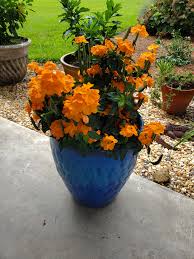
Crossandra growing in partial shade on a patio. Photo courtesy of Daniel Leonard.
Adding to Crossandra’s appeal, the species couldn’t be easier to grow if you give it the right conditions. Crossandra prefers to be sited in areas that receive ample sunlight but also get a reprieve from the hottest afternoon rays. This year, I grew one on a deck that receives sun from about 10 am – 2 pm and is then provided filtered shade from a large tree the rest of the afternoon; these conditions seem to be ideal. Crossandra performs best in moist, well-drained soil, making potting mix an excellent option. Daily watering in the summer combined with our (hopefully) frequent rainfall in July and August keeps it wilt-free. I also apply slow-release fertilizer at planting and then supplement with liquid fertilizer periodically throughout the summer. This, combined with regular irrigation, promotes healthy, vigorous growth, and allows the flower show to continue uninterrupted until cool weather finally draws the curtains.
Crossandra is a versatile plant in container gardens, shining in either the role of filler in larger containers or as a solo specimen plant in its own container. In mixed containers, play off of Crossandra’s orange flowers with partial sun foliage plants like Coleus, Elephant Ears, or Hawaiian Ti, or flowering annuals like Browallia ‘Endless Illumination’, Torenia (Wishbone Flower), Blue Daze, or Purple Heart Plant. While Crossandra does well in mixed containers, as a UF graduate, I prefer to stick it in my favorite blue pot for an orange and blue Gator themed solo container!
Regardless of how you choose to incorporate Crossandra into your garden’s design, it will reward you with summer-long orange flowers in a low-maintenance package. Simply place it in morning to early afternoon sun, give it ample water and adequate fertilizer, and enjoy this Florida Friendly Landscaping approved species. Plant one today!
For more information about Crossandra or any other horticultural topic, contact your local UF/IFAS County Extension office.











